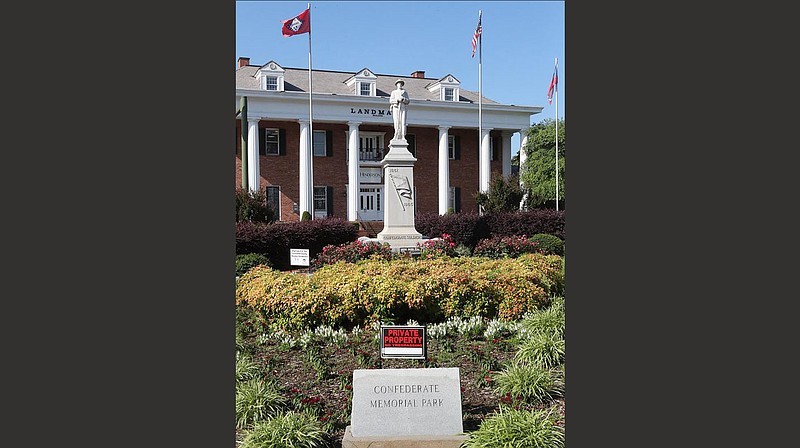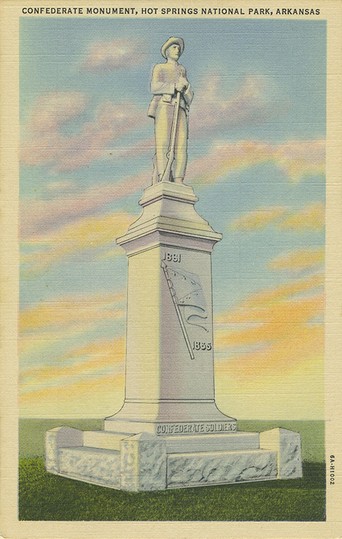Hot Springs Confederate Monument
Introduction
Text-to-speech Audio
Images
Hot Springs Confederate Monument

Hot Springs Confederate Monument Postcard

Backstory and Context
Text-to-speech Audio
Following the attack on Fort Sumter and President Abraham Lincoln's call for troops to put down the rebellion in 1861, Arkansas and several other Upper South states seceded and joined the nascent Confederacy. Hot Springs and the surrounding area provided many men for the Confederate army, and a few for the Union army as well. The town played brief host to the Arkansas state government in 1862, and several small skirmishes occurred in the town's vicinity. Never directly occupied by armed forces, Hot Springs did suffer the economic consequences of the war and wartime fires consumed much of the town.
In the early 20th century, the local chapter of the United Daughters of the Confederacy (UDC) sought to erect a monument to the region's Confederate veterans. The UDC erected many such monuments across Arkansas and the South; these monuments and their dedication ceremonies were often steeped in Lost Cause ideology, which minimized Confederate defeat, downplayed slavery's role in starting the war, and reinforced white supremacy in the South.
The UDC ultimately placed two Confederate monuments in Hot Springs, both of which took a long to time to become a reality. The first discussions for a local Confederate monument began in 1907, shortly after the UDC took ownership of the Confederate veterans' section of the local Hollywood Cemetery. Following a decade of fundraising, the UDC placed a Confederate monument in the cemetery in 1919. Yet the UDC continued to raise funds for yet another monument in the town of Hot Springs itself.
The UDC's fundraising efforts continued slowly over several ensuing decades. Only with a final contribution of $1,000 from the Arkansas state UDC organization were the necessary funds finally raised. The final cost was $5,000. The UDC contracted with the McNeel Marble Company of Marietta, Georgia, which specialized in Confederate monuments and built several others for Arkansas towns. The 18-foot tall monument features a marble Confederate sentinel atop a granite base. In 1933, the City of Hot Springs agreed to allow the UDC to erect its monument at Como Triangle--a small, triangular spot of land at corner of Market Street, Central Avenue, and Ouachita Avenue.
Como Triangle holds a dark past, the site of two 20th centuries lynchings of Black men. In June 1913, Will Norman was accused of assaulting and killing a white woman named Garland Huff, the daughter of a local judge. Norman was seen fleeing the scene (the only direct evidence against him) and was caught following a town-wide manhunt. A mob of several hundred hung him at the Como Triangle, shooting his corpse and finally burning the body. Hundreds were on hand to watch the affair, and "a morbid crowd" picked through the charred remains the following day for souvenirs. In August 1922, Gilbert Harris was arrested for the murder of local businessman Maurice Connally and a series of break-ins. A large mob gathered at the county jail, broke in, held police officers at gunpoint, and brought Harris to the Triangle to hang him. Gilbert's lynching was the last in Arkansas.
Thus when the Hot Springs Confederate Monument was finally dedicated in 1934, the statue stood on the death site of two Black men within recent memory. The dedication itself featured a variety of speakers, including a local reverend and Hot Springs Mayor Leo McLaughlin. Notably, the keynote speaker was Mrs. C.S. Lothrop, somewhat unusual given that most monument dedications featured male orators (often former Confederate veterans or politicians). Mrs. Lothrop "paid a very beautiful tribute to the heroes of the Confederate army and to all the Southern heroes."[1] The Hot Springs monument was the last one dedicated by the UDC in Arkansas. In 1953, the city granted the UDC the deed to Como Triangle. In 1996, it was listed on the National Register of Historic Places.
In 2017, Hot Springs Manager Bill Burrough first approached the UDC about relocating the monument, and in June 2020, in the wake of George Floyd's death and a national discussion over systemic racism and Confederate iconography, Burroughs tried again. An online petition likewise gathered over 10,000 signatures calling for the statue's removal. Yet while the city maintains care of the monument, the land and monument themselves belong to the UDC, which has stoutly refused to relocate the monument. The UDC has agreed to cease flying the Confederate flag above the monument.
Sources
1. Mark K. Christ. "Hot Springs Confederate Monument." June 9, 2020. Encyclopedia of Arkansas. Web. Accessed July 23, 2020. https://encyclopediaofarkansas.net/entries/hot-springs-confederate-monument-13208/
2. Charles Russell Logan. "Something So Dim It Must Be Holy": Civil War Commemorative Sculpture in Arkansas, 1886-1934. Little Rock: Arkansas Historic Preservation Program, 1996. Digitized. http://www.arkansaspreservation.com/News-and-Events/publications
3. Guy Lancaster. "Lynchings hidden in the history of the Hot Springs Confederate monument." August 18, 2017. Arkansas Times. Web. Accessed July 23, 2020. https://arktimes.com/arkansas-blog/2017/08/18/lynchings-hidden-in-the-history-of-the-hot-springs-confederate-monument
4. Cassidy Kendall. "Hot Springs given 2 options to move Rebel statue." June 13, 2020. Arkansas Democrat-Gazette. Web. Accessed July 23, 2020. https://www.arkansasonline.com/news/2020/jun/13/city-given-2-options-to-move-rebel-statue/
5. Wendy Richter. "The Impact of the Civil War on Hot Springs, Arkansas." Arkansas Historical Quarterly. Vol. 43, No. 2 (Summer, 1984): 125-142.
6. Nancy Snell Griffith. "Will Norman (Lynching of)." November 21, 2019. Encyclopedia of Arkansas. Web. Accessed July 23, 2020. https://encyclopediaofarkansas.net/entries/will-norman-9303/
7. Malcolm L. Rigsby. "Gilbert Harris (Lynching of)." November 21, 2019. Encyclopedia of Arkansas. Web. Accessed July 23, 2020. https://encyclopediaofarkansas.net/entries/gilbert-harris-8242/
8. "Petition calls for removal of Confederate statue from downtown Hot Springs." June 6, 2020. Fox 16 News. Web. Accessed July 23, 2020. https://www.fox16.com/news/petition-calls-for-removal-of-confederate-statue-from-downtown-hot-springs/
9. Mark K. Christ. "Hollywood Cemetery-Confederate Section." November 11, 2016. Encyclopedia of Arkansas. Web. Accessed July 26, 2020. https://encyclopediaofarkansas.net/entries/hollywood-cemetery-confederate-section-7761/
Richard Rasmussen, The Sentinel-Record, https://www.arkansasonline.com/news/2020/jun/13/city-given-2-options-to-move-rebel-statue/
Butler Center for Arkansas Studies, https://encyclopediaofarkansas.net/media/hot-springs-confederate-monument-13823/
